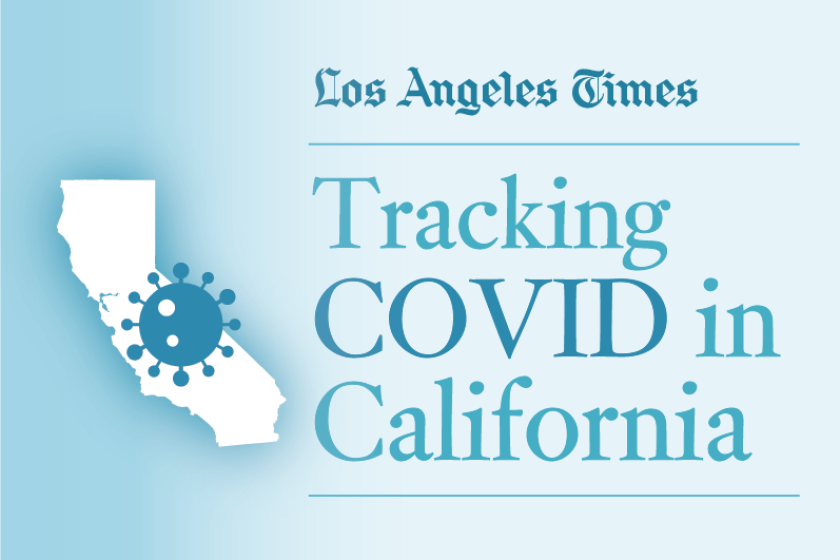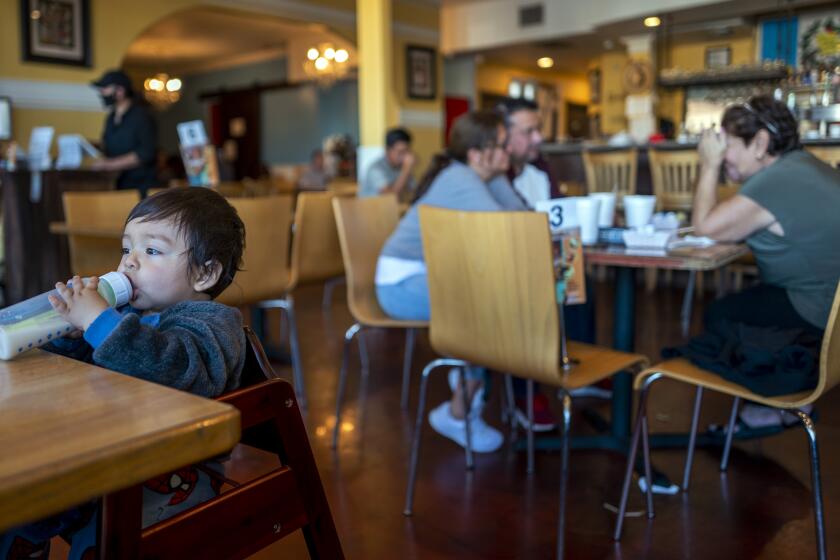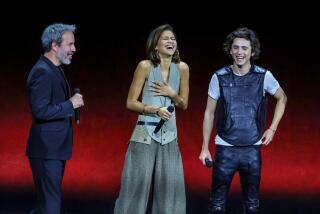Movie theater safety during COVID, the sequel: This time it’s personal

- Share via
Two years into the COVID-19 pandemic, and a year after The Times asked public health experts and film exhibition industry leaders about its effect on attending movies safely, what has changed? We have seen new, more contagious variants. We have seen more incidents of resistance to protocols, keeping the behavior of strangers the most troubling of wild cards. But we also have seen a massive accumulation of knowledge about the disease and how it spreads — and the introduction of a key element making cinema attendance safer: the vaccines.
“As opposed to the last time we talked, there are a lot more tools in the toolkit that make gatherings such as going to a movie theater much more possible” to do safely, says Dr. Peter Chin-Hong, an infectious disease specialist at UC San Francisco who also spoke with The Times in November 2020. “In the past, we didn’t have vaccines. We didn’t have any chance of treating people early. Now we have oral pills for COVID, monoclonal antibodies — and vaccines, which is the most important difference.”
Checking in again with the health experts and industry leader interviewed for that November 2020 story reveals that recommendations remain largely the same: Wear masks indoors (though now medical-grade masks such as N95s are suggested in the face of the much more contagious Omicron variant) and maintain social distancing. All three agree getting vaccinated, including the booster shot, is the most important piece of the puzzle.
But while there’s visible exhaustion, even frustration, among the medical professionals, there’s also an upbeat message: With more agency than a year ago, audiences can make moviegoing a safer experience, depending on their comfort with levels of risk — and, of course, the behavior of those around them. “The overall theme is layering things on top of each other so you’re not putting all your eggs in one basket,” Chin-Hong says. “So when I say you get one hour of protection from a surgical mask, that doesn’t assume vaccines or ventilation. It all increases based on these other strategies you have.”
While new case numbers remain high in California (as of this writing, the 125,861 new cases reported last week represented a 1.8% increase from the previous week), the numbers continue to show overwhelming advantages for the vaccinated. In the latest data posted by the state on its official COVID-tracking site, the unvaccinated were 4.1 times more likely to contract the virus than the vaccinated. Chin-Hong cited data from multiple sources indicating the vaccinated were considered nearly 90% less likely to become seriously ill from COVID-19, should they suffer a breakthrough infection, and “close to 100%” less likely to die from the disease, other serious illnesses in conjunction with COVID-19 aside.
“I was [on shift] in the hospital last week and pretty much nobody I took care of was boosted,” says Chin-Hong. “It’s pretty much all nonvaccinated and immunocompromised.”
To health experts such as Chin-Hong and Dr. Georges Benjamin, executive director of the American Public Health Assn., this means people have effective tools to make activities such as movie attendance much safer.
“People should not be hiding away,” says Benjamin. “I think it’s OK to go to the theater, but go with protection. And your eyes open.
“Outside is better than inside, so if you’re going to the movies, be fully vaccinated and masked. I wasn’t a fan of vaccine passports before, but I’m there now. There’s equitable access to vaccines. If a business wants you to show a vaccine card, there’s no reason why you shouldn’t. I would require people to wear a mask in common areas. And of course, I’d give caution to people with underlying medical problems.”
Chin-Hong supported the idea of requiring proof of vaccination to attend indoor events: “I think the minimum is two [doses]; more and more people are moving toward boosters as the minimum. Again, not putting all eggs in one basket: If you’re vaccinated, you should still be wearing a mask.”
The health experts agreed with Patrick Corcoran, vice president and chief communications officer for the National Assn. of Theatre Owners, that there still has not been a COVID-19 outbreak conclusively tied to movie theater attendance — “nowhere in the world,” he says. Of course, there are multiple factors making such a tie extremely difficult to definitively establish, as opposed to, say, certain events that have been deemed “super spreaders” through contact tracing and other evidence. That’s still a case of the absence of bad news potentially being good news.
“The key has been governmental policies opening up vaccinations to all adults, as well as CDC revising its policies and deferring to state and local conditions,” Corcoran says. “We still have [industry-standard safety protocols] CinemaSafe, but cinemas should look to their localities for the proper way to operate.
“The other major change has been [improved] understanding of how the virus spreads. The initial recommendation from almost every public health official was to disinfect and clean surfaces; that has proven to not really be the way it’s transmitted — it’s aerosol.”
Corcoran cites vaccines as the most important factor in movie attendance maintaining a low risk level. “The other thing has been ventilation,” he says. “In movie theaters, the ventilation is surprisingly good compared to other places. A 10-screen cineplex will typically have 11 air-conditioning units, sometimes 12. You’re not sharing air from auditorium to auditorium. Air in movie theaters tends to rise; it’s sucked out and replaced over a fairly brief time.”
Chin-Hong agrees: “Movie theaters are well ventilated. Some of these new cineplexes are like going on a plane, essentially, or another well-ventilated area. That’s very little risk.”
Corcoran said locations and activities where spread has been high — nursing homes, churches, family gatherings, weddings — “have to do with close, intimate contact and a lot of activity. At a movie theater, you’re sedentary for the most part. Your respiration is lower.”
Members of Corcoran’s organization comply with local mandates; would they impose mask and vaccination mandates where they aren’t in place locally?
“Some do,” says Corcoran. “Obviously, it will vary from company to company. In the southern tier of the country, there have been very few mandates. Some theaters have required masks anyway, but it’s hard to get in front of your public health officials.”
Proof of vaccination is now required at Los Angeles restaurants, gyms and scores of other businesses.
Some of those local rules (or lack thereof), however, can increase risk. Individuals should find out if the theater they want to attend conforms to rules within their comfort zone. Does that locality or cinema require proof of vaccination? Does it enforce a two-seat buffer between parties to maintain social distancing?
“Being shoulder to shoulder with someone during Omicron is not a good idea,” says Benjamin.
While the health experts, appeared visibly more exhausted and frustrated than a year ago, they expressed hope. Both agreed with recent reports that the Omicron variant may have passed its peak in some areas, and both cited the vaccines as having the potential to return society to some semblance of normalcy as it was thought of in 2019.
Movie attendance seems to be on the rebound. While 2021 box office was down 61% from 2019 levels, that still represented an improvement from the dark days of 2020 — and attendance trended upward throughout the year, according to statistics provided by Corcoran. Rescued, of course, by a certain web-slinger (“Spider-Man: No Way Home” is the only billion-dollar grosser of the pandemic), box office leaped from 11% of 2019 first-quarter figures to 73.3% of 2019 fourth-quarter figures during the comparable periods last year.
And while the behavior of strangers remains the top concern of those interviewed, Corcoran says the public acts of belligerence have largely passed by cinemas.
“We have seen it from time to time. It’s no secret that there are people who are very militant on both sides of these protocols. We see people going in both directions. A recent study from NRG shows older customers — who are more hesitant to do anything — they’re more hesitant to go to church than to a movie theater.”
So how does that affect theater employees’ ability or willingness to enforce policies such as mask-wearing during the show? Corcoran says, “If it’s a legal responsibility, if your business is going to be fined, you’re going to enforce it. Nobody wants to lose a customer, but it’s better to lose an uncooperative one than a cooperative one.”
Chin-Hong says, “People’s exhaustion is getting greater and greater; look at Asian hate — that hasn’t abated. It’s an underlying symptom of people’s frustrations.”
Benjamin says, “This has been a pressure test to the resilience of our society. We have people who are acting out in a variety of ways. I think they’re the tip of the iceberg. These are representations of the enormous stress society is under. Even the most resilient among us are under stress. We’re in a very explosive place.
“Those playground rules still apply: Treat others with respect, put your toys away. All those things we learned in kindergarten, those rules still apply.”
Says Corcoran: “It’s entirely about social trust, and that will grow as more people become vaccinated. Our biggest thing is we need our consumers to get vaccinated. That’s the solution for everybody and for every business.”
Though each of these interviews was conducted individually, if it sounds as if NATO is in lock-step with public-health experts, that’s because it is. Corcoran emphasizes that the theater organization has listened to the experts from the start.
“We survive and thrive based on our customers, and we have to have that trust with them,” says Corcoran.
Chin-Hong emphasized that the dangers remain real, but customers can minimize risk: “You can customize your experience to make it safer. You can go to the movie theater but watch the situation in your community. Go at a time of day when there are fewer people. The movie theater is safer than indoor dining; people are in their seats. The concession stand might be risky, where people are mingling, and when they go to the bathroom — but we’ve come a long way from a year ago.”
Benjamin said, “Two years ago, we didn’t have the tools to normalize life in our society. We now have the tools to do so. We just have to use them responsibly, utilize the best science, understanding it will change over time as we learn more. All pandemics end, either because they go away or we learn to adapt to them. We’re not there yet, but they do.”
The ABCs (and D) of safely going to the movies
Dr. Peter Chin-Hong offered this A-B-C-(also C)-D of attending movies safely, apart from the basic tenets of safety: Be vaccinated and boosted, wear a mask and observe social distancing.
“A is for assessing who you are, what’s in your situation. Are you immuno-compromised, older or living with someone who’s elderly or compromised? You’ll have to be more careful.
“B is for boosters: They keep you away from the hospital. Even with a breakthrough, you’re about 90% protected from the hospital and nearly 100% from dying” unless you have other significant illness.
“C is for children. About 5-year-olds can be vaccinated and about 12-year-olds can be boosted. That will make it a safer environment: You want to make sure there’s a wall of immunity around you.
“C is also for Concessions — the most risky part of the movie theater. Being where the popcorn is, is risky. It’s safer to take it back to your seat. But to really reduce the risk, don’t eat or drink at all in the theater. But it’s better than a restaurant — it’s more controlled than indoor dining.
“D is for diagnostic tests. If you’re worried about exposure, say some of your friends got sick in the same setting, you test Day 3 to [Day] 5 after the event.
More to Read
Only good movies
Get the Indie Focus newsletter, Mark Olsen's weekly guide to the world of cinema.
You may occasionally receive promotional content from the Los Angeles Times.













